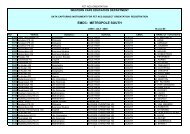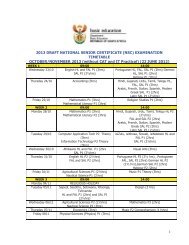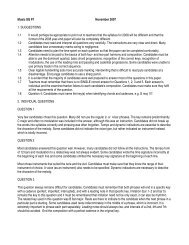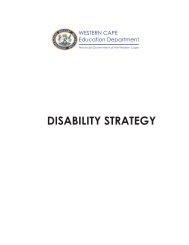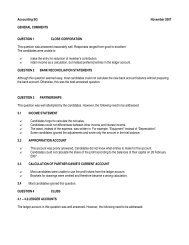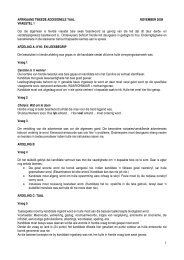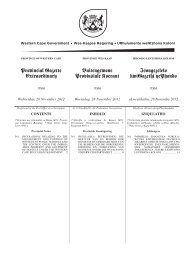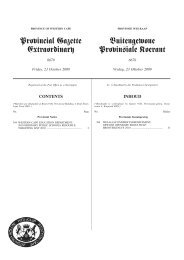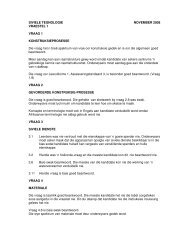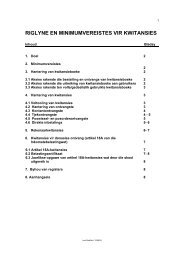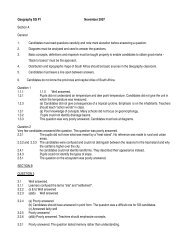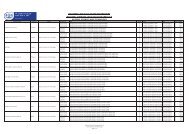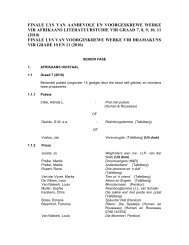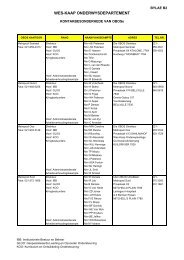life orientation guidelines for common assessment task grade 12 2012
life orientation guidelines for common assessment task grade 12 2012
life orientation guidelines for common assessment task grade 12 2012
Create successful ePaper yourself
Turn your PDF publications into a flip-book with our unique Google optimized e-Paper software.
LIFE ORIENTATIONGUIDELINES FOR COMMONASSESSMENT TASKGRADE <strong>12</strong>20<strong>12</strong>These <strong>guidelines</strong> consist of 9 pages.Copyright reservedPlease turn over
Life Orientation 2 DBE/20<strong>12</strong>NSC – Examination GuidelinesLIFE ORIENTATION GRADE <strong>12</strong> NSC GUIDELINE FOR THE COMMON ASSESSMENTTASK1. INTRODUCTIONIn order to assist with the development of a <strong>common</strong> standard of <strong>assessment</strong> in LifeOrientation at Grade <strong>12</strong> level, one of the five <strong>assessment</strong> <strong>task</strong>s will be designed at allschools. The examination administered in the third quarter will be set nationally and is inthis case referred to as the Common Assessment Task. In order to assist teachers in theirpreparation of learners <strong>for</strong> the Grade <strong>12</strong> <strong>common</strong> <strong>assessment</strong> scheduled <strong>for</strong> 20<strong>12</strong>, theDepartment of Basic Education is providing schools with an Assessment Guideline thatstipulates the minimum standards that must be covered by all learners. Schools arenevertheless encouraged to ensure that all <strong>assessment</strong> standards prescribed in theNational Curriculum Statement are covered.This guideline document must be read in conjunction with the Subject AssessmentGuideline <strong>for</strong> Life Orientation (SAG 2008), the Learning Programme Guideline <strong>for</strong> LifeOrientation (LPG 2008) and the National Curriculum Statement Grades 10–<strong>12</strong> LifeOrientation. Some material from the Subject Assessment Guideline has been included inthis document <strong>for</strong> easy reference.2. STRUCTURE OF THE LIFE ORIENTATION COMMON ASSESSMENT TASKThe Life Orientation <strong>assessment</strong> consists of a 1½ hour paper of 75 marks. The questionpaper is divided into three sections. SECTIONS A and B are COMPULSORY. InSECTION C, learners must answer TWO of the three questions. The detailedrequirements <strong>for</strong> each section are indicated below:Outline <strong>for</strong> examinationsThe outline provided below serves as a guideline <strong>for</strong> the setting of Life Orientationexamination papers.The suggested weighting of the cognitive levels <strong>for</strong> the examination is as follows:Weighting Cognitive level Bloom's Examples of verbsTaxonomy30% Lower order Levels 1 & 2 What? Why?, Who?, List40% Middle order Levels 3 & 4 Discuss, Explain, Describe30% Higher order Levels 5 & 6 Evaluate, Synthesise,Critically evaluate,ExamineThe following command verbs/words are included to illuminate the revised Bloom'sTaxonomy:(NOTE: The definitions below are mainly from Hornby, AS. (1995) Ox<strong>for</strong>d: AdvancedLearner's Dictionary; Ox<strong>for</strong>d University Press. Ox<strong>for</strong>d. The list includes verbs used mostfrequently in the 'competence descriptions'. Teachers may wish to consult this, or otherdictionaries, to find proper definitions of other verbs.)Copyright reservedPlease turn over
Life Orientation 3 DBE/20<strong>12</strong>NSC – Examination GuidelinesAnalyse:to break down in<strong>for</strong>mation into components/parts and involves recognising what isimportant and how the parts are relatedApply:to use knowledge and understanding of Life Orientation and make it relevant to asituation, issue or problemAssess:to estimate the nature, quality or value of something. To make a value judgementthat must be properly justifiedComment:to give an opinion on, to explain or criticize an event, behaviour or a situation. Priorknowledge is essential and learners are invited to make a judgement based uponthe evidence they can relate to their knowledgeCompare:to examine things to see how they are alike and how they are differentDesign/Create:to put together ideas or elements to develop an original idea or engage in creativethinkingCritically analyse:to express approval or disapproval, or to find faults or virtues and to providereasonsDefine:to give the exact meaning of a term or concept using wordsDescribe:to give an account of something (recall knowledge or state what is observed)Discuss:to talk or write about something; compare a number of possible views about anissue or problem and to weigh up their relative importance. A conclusion isessential.Do you think:invites learners to put <strong>for</strong>ward their own opinions about an issue or problem.However, marks will always be awarded <strong>for</strong> the quality of the arguments put <strong>for</strong>wardand not <strong>for</strong> individual opinionsEvaluate:to <strong>for</strong>m an idea of the amount, quality or value of something; or, to compare anumber of possible views about an issue or problem and weigh up their relativeimportance; to make judgements on account of general criteriaExamine:to look at something carefully and in detail in order to learn something about it;break down an issue or problem (as in 'analyse') and to understand it – state whathas been learntExplain:to make something plain or clear, to simplify; to describe something in detail so thatit can be understood. Mentioning examples is essential.Identify:to single out from other in<strong>for</strong>mationList:to state in the briefest <strong>for</strong>mCopyright reservedPlease turn over
Life Orientation 4 DBE/20<strong>12</strong>NSC – Examination GuidelinesMention:to write or speak something without explainingName:Similar to 'mention' e.g. Name TWO reasons <strong>for</strong> poverty.Suggest:to give possible reasons or ideas. These must be plausible but not necessarilycorrect.To what extent:invites learners to explain and analyse and then comment on the relativeimportance of argumentsSECTION A: 25 MARKS1. All questions are COMPULSORY.2. This section should incorporate all 4 Learning Outcomes.3. The questions must be objective-type questions, testing factual knowledge.4. Questions to vary from simple to complex.5. The mark allocation will range between 1–2 marks.QUESTION 1: Multiple-choice 10 Items 3 lower-order questions4 middle-order questions3 higher-order questions (10 x 1) (10)QUESTION 2: True/False 3–5 items lower to higher order (5 x 1) (5)QUESTION 3: Matching items 5 items lower to higher order (5 x 1) (5)QUESTION 4: Questions requiring 1–2 word responses. 5 items lower to higher order (5 x 1) (5)SECTION B: 30 MARKS1. This section should incorporate all 4 Learning Outcomes.2. The questions must be knowledge based, current, up-to-date, age appropriate andlearner-friendly.3. Questions to vary from simple to complex.4. All questions are COMPULSORY.5. The mark allocation will range between 2–5 marks.QUESTION 5: 1–2 items Scenario-basedlower to higher orderQUESTION 6: 1–2 items Scenario–basedquestions lower tohigher orderQUESTION 7 1–2 items Case studyquestions lower tohigher orderCopyright reserved1 item = 10 marks or2 items = 5 markseach1 item =10 marks or2 items = 5 markseach1 item = 10 marks or2 items = 5 markseachPlease turn over
Life Orientation 5 DBE/20<strong>12</strong>NSC – Examination GuidelinesSECTION C: 20 MARKS1. Each question should focus on the content of one specific Learning Outcome or itcan integrate content from different Learning Outcomes.2. Application questions: solve problems, make decisions, give advice, etc. A shorttext/diagram/data can be provided as a stimulus.3. Three (3) questions will be set of which learners will be expected to answerTWO (2).4. Each question will carry 10 marks. The questions will require extended responsesthat will assess middle to higher order thinking, i.e. short written paragraphs.TOTAL FOR EXAMINATION: 75 MARKS3. TEST GRIDMARKS: 75 MINUTES: 90LO's AS's No. ofMarksItem Type Cognitive Levels CognitiveSkillsSECTION ACOMPULSORYLO 1- 4 This section shouldincorporate all 4 LearningOutcomes 1–4Assessment standards ascovered in LO 1–425MCQT/FMC1-2 WordsLowMediumHigh10 5 5 5 30% 40% 30%KnowledgeComprehensionApplicationLO's AS's No. ofMarksItem Type Cognitive Levels CognitiveSkillsSECTION BCOMPULSORYLO 1- 4 This section shouldincorporate all 4 Learning Outcomes1–4Assessment standards as coveredin LO 1–4ScenarioSource basedCase StudyLowMediumHigh30 10 10 10 30% 40% 30%KnowledgeComprehensionApplicationCopyright reservedPlease turn over
Life Orientation 6 DBE/20<strong>12</strong>NSC – Examination GuidelinesSECTIONC – CHOOSE 2 OF THE 3OPTIONSLO's AS's No. ofMarksLO 1–4 This section may incorporate all 4Learning OutcomesAssessment standards as covered inLO 1–420Item Type Cognitive Levels CognitiveSkillsExtended responsesthat include evaluation,analysis3 questions will be setof which learners willbe expected to answerTWO(10 x 2)LowMediumHigh30% 40% 30%KnowledgeComprehensionApplication4. CONTENT AND CONTEXT GUIDELINESThe following framework is designed to assist teachers in preparing learners with the coreknowledge and concepts required <strong>for</strong> the Grade <strong>12</strong> <strong>common</strong> examination.LO AS Core knowledge and conceptsLO 1: Personal Well-BeingThe learner is able to demonstrate knowledge, values, attitudesand skills to achieve and maintain personalwell-being.AS 1:Applies a range of <strong>life</strong>skills, evaluates own abilityto prevent and managesstress and adapts tochange as part of anongoing healthy <strong>life</strong>stylechoice.AS 2:Discusses the importanceof initiating, building andsustaining positiverelationships with familyand peers as well as in theworkplace and the broadersocial context.AS 3:Investigates the humanand environmental factorsthat cause ill health,accidents, crises anddisasters and exploresappropriate ways to dealwith them.Concepts: stressors, managing stresses and change,<strong>life</strong>style choices Good stress (eustress) and bad stress (distress) Types of stressors, e.g. physical, emotional, socialetc. Symptoms of stress Managing stress/change Stress management activities/coping mechanismsConcepts: initiating, building and sustaining relationships,positive relationships, relationships in different contexts Types of relationships Characteristics of positive relationships Role and maintenance of relationship, e.g.communication, dealing with conflict, rights andresponsibilities in relationshipsConcepts: factors causing ill health, accidents, crises anddisasters; managing human and environmental factors thatimpact on health Identify and deal with human and environmentalfactors that impact negatively on health, e.g.environmental disasters, safety skills etc. Making decisions: strategy/model <strong>for</strong> making anin<strong>for</strong>med decision Community responsibility and educational/intervention programmes to promote safety andhealthy living at various levels.Copyright reservedPlease turn over
Life Orientation 7 DBE/20<strong>12</strong>NSC – Examination GuidelinesLO 2: Responsible CitizenshipThe learner is able to demonstrate competence, commitment and an understandingand appreciation of the values and rights that underpin the constitution in order topractice responsible citizenship and to enhance social justice and sustainable living.AS 4:Investigates how unequalpower relations betweenthe sexes are constructedand how they influencehealth and well-being andapply this understanding towork, cultural and socialcontexts.AS 1:Participates in andevaluates services offeredby a community project ona contemporary social orenvironmental issue and toevaluate own contributionto the project.AS 2: Evaluates ownpositions taken whendealing with discriminationand human rightsviolations, taking intoaccount the Bill of Rights.AS 3:Analyses and debates therole of the media in ademocratic society.AS 4:Reflects on and explainshow to <strong>for</strong>mulate apersonal mission statementbased on core aspects ofpersonal philosophies,values, beliefs, religionsand ideologies, which willin<strong>for</strong>m and direct actions in<strong>life</strong> and contributemeaningfully to society.Concepts: unequal power relations, impact of unequalpower relations on well-being, different contexts Issues surrounding power balance and powerstruggles between the sexes How and why power relations emerge between thesexes The abuse of power in relationships within differentsettings e.g. workplace, domestic, cultural etc. Management of power relations between sexes indifferent contexts to encourage a win-win situationConcepts: community projects, social and environmentalissues Types of community projects: volunteer versus paid Evaluate community projects/ services (their purposeand contribution) and how learners can get involvedConcepts: opinions on human rights issues, discriminationand human rights violations, Bill of Rights Learners must be able to do the following withregards to discrimination and human rights violationswithin the context of the Bill of Rights:1. State and evaluate own position2. Identify what influences their position3. How to accommodate/respect conflictingpositions4. How to communicate their positionConcepts: Role of the media, democratic society Analyse role and responsibility of the media Accessibility of media generated in<strong>for</strong>mation Evaluate the extent to which media access andmedia reporting reflects a democratic society, e.g.positions taken by editors, space allocated to topics,availability etc.Concepts: personal mission statement, <strong>life</strong> actions,responsible citizenship Learners to be conscious of their <strong>life</strong> views, beliefsystems, values, religion etc. Purpose of mission statement How their vision and philosophies will impact:1. their own actions2. their immediate communities3. society at largeCopyright reservedPlease turn over
Life Orientation 8 DBE/20<strong>12</strong>NSC – Examination GuidelinesLO 3: Recreation and Physical Well-BeingThe learner is able to explore and engage responsibly in recreation and physical activities,understanding the relationship between participation and well-being.AS 1:Monitors and evaluatesown progress in theachievement of personalfitness and health goalsthrough regularparticipation in aprogramme.AS 2:Evaluates and participatesin various relaxation andrecreational activities, sportand games with the view tomaking a choice aboutparticipation and long-termengagement in at least oneactivity.AS 3:Reports on theopportunities of careersand work in the recreation,fitness and sport industries.AS 4:Investigates howideologies, beliefs andworld views influence theconstruction of andparticipation in arecreational and physicalactivity.Concepts: achievements of goals, value of regularparticipation Health-related and skills-related fitness norms andper<strong>for</strong>mance requirements Identify components of fitness Design and evaluate a programme <strong>for</strong> developmentof health-related fitnessConcepts: the value of sporting activities, relaxation/recreational activities and long term engagement Develop criteria <strong>for</strong> evaluating programmes, sportand games Factors influencing choices: interests, accessibility,perceived benefits, areas of potential The different benefits of long term engagement andparticipation.Concepts: Career and work, recreation, fitness and sportindustries Learners must be able to do the following withregard to careers in this sector:1. Study trends and demands2. Explore possible routes to the sector –programmes and admission requirements <strong>for</strong>higher education etc.3. Analyse the different types of jobs in thesector, identify work settings, activities andopportunities in each sectorConcepts: recreation and physical activity, how differentperspectives influence participation Discuss how beliefs, ideologies and worldviewsinfluence participation in sport and recreationalactivities across cultures and genders Make comparisons between urban and ruralparticipation in different sporting and recreationalactivities across cultures and genders Compare and explain differences in participationtrends of westernised societies to more traditionalsocieties across different cultures and gendersCopyright reservedPlease turn over
Life Orientation 9 DBE/20<strong>12</strong>NSC – Examination GuidelinesLO 4: Career GuidanceThe learner is able to demonstrate self-knowledge and the ability to make in<strong>for</strong>med decisionsregarding further study, careers fields and career pathing.AS 1:Commits to a decisiontaken and appliesaccordingly <strong>for</strong> a job or acourse in additional orhigher education.AS 2:Explores careeropportunities within chosenfield and investigate otherinnovative solutions(includingentrepreneurship) as waysin which to counteractpossible unemployment.AS 3:Investigates and reports onthe core elements of a jobcontract, conditions ofservice, relevant labourlaws and practices, theprinciples of equity andredress, the value of workthe importance of workethic.AS 4:Reflects on the process of<strong>assessment</strong> andexamination writing skillsand applies these skills.Concepts: applications <strong>for</strong> jobs/study Decision making with regards to studies/careers Evaluate letters of application and a CVConcepts: Opportunities in career fields, counteractingunemployment, entrepreneurship Awareness of types of jobs and opportunities Reasons <strong>for</strong> and impact of unemployment Entrepreneurship – necessity, skills, opportunities,viability, tax implications etc. Problem solving and creative thinkingConcepts: Labour issues, work ethic, redress Job contracts:1. Obligations2. Conditions of service3. Core elements (e.g. working hours,remuneration etc.) Principles and understanding of Basic Labour laws:1. Labour Relations Act2. Basic Conditions of Employment Act3. Employment Equity Act (know history of)4. Broad-Based Black Empowerment Act5. Skills Development Act Recruitment Process Trade unions Evaluation of post school options Analyse job advertisementsConcepts: Examination writing skills, process of <strong>assessment</strong> Evaluate and reflect on the role of <strong>assessment</strong> intheir development Adapt and evaluate study skills, strategies and stylesof learning Examination skills (read the question, plan theresponse, answer the question, time managementetc.)5. CONCLUSIONTEXTBOOKS: Teachers are encouraged to use the DBE approved textbooks that complywith the requirements of the NCS guideline <strong>for</strong> Life OrientationTeachers should infuse contemporary Life Orientation issues, newsprint articles etc. in theteaching of the subject.Copyright reserved



